Myoglobin release is strongly associated with muscle damage; therfore, it would most closely match a diagnosis of massive muscle trauma in this question.
Myoglobinuria is MOST likely to be noted in urine specimens from patients with which of the following disorders?
May-Hegglin anomaly is a rare autosomal dominant condition in which patients are at risk for bleeding and infections. It is characterized by the presence of large Dohle body like inclusions within neutrophils, eosinophils, basophils, and monocytes.
The WBC anomaly indicated by the arrow in this illustration is:
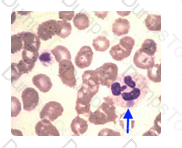
Which advancement in clinical science occurred during the second half of the twentieth century?
Thrombocytes, or platelets, are of course involved with hemostasis, not immunity.
Immunology
Which of the following would not be considered a part of the body's cellular immune system:
Though it may not be required, TDM should still be used to confirm adequate dosing. Genotyping does not make TDM redundant.
A PM will metabolize the drug more slowly and therefore will need lower doses. CYP2D6 metabolizes many different drugs; it is not associated with just one class of drugs. Anytime a drug is taken that competes for the same metabolizing enzyme as another drug, there is potential for the concentrations of both drugs to be increased.
A patient has been characterized as a CYP2D6 poor metabolizer (PM) after genotyping. Which of the following statements is not true?
Antidiuretic hormone, or ADH, has the important role of conserving body water by reducing the loss of water in urine by changing the water permeability of the distal tubule and collecting duct. An increase in ADH causes a concentrated urine since the water is retained and absorbed through the permeable membrane. An decrease in ADH causes the collecting ducts to retain very little water, instead it is excreted as urine.
Chemistry
Which of the following action describes the MAJOR property of antidiuretic hormone?
All the following characteristics are accurate for the influence of Health Insurance Portability and Accountability Act (HIPAA) except
In sickle cell anemia, rapid hemoglobin turnover may be present. HbA1C and other glycated hemoglobin assays are not valid in rapid hemoglobin turnover and in abnormal hemoglobin conditions. Fructosamine measurements can be used because of shorter half life of albumin.
HbA1C measurements are NOT ordinarily used to monitor long-term diabetic control in a diabetic with sickle cell anemia.
CAMP is the correct answer because the case is typical of Streptococcus agalactiae(Group B strep). The main presumptive identification test is CAMP. Bile solubility is positive for Streptococcus pneumonia. Coagulase would be positive for Staphylococcus aureus. PYR is positive for Streptococcus pyogenes (Group A strep) which is ruled out by the resistance to bacitracin.
Microbiology
Spinal fluid cultures on a 3-day-old infant revealed beta-hemolytic, Gram-positive cocci occurring in pairs and chains. The organism was catalase-negative and bile esculin-negative. Resistance to 0.04 U disk of bacitracin was noted. The other test necessary to identify this organism is a positive test by:
Either immunofixation or immunoelectrophoresis can be used to confirm Bence-Jones proteinuria.
Which of the following methods would be used to confirm the presence of Bence-Jones protein in the urine:
The approximate volume of CSF in an adult is 90-150 mL.
What is the approximate volume of spinal fluid in an adult?
Match each of the descriptions with the appropriate magnification:
1. Color, Rouleau, Overall Slide Quality, Cell Distribution
2. Platelet estimates RBC-platelet-WBC morphology WBC differential RBC inclusions
3. Select area to examine, WBC estimate
Cerebrospinal fluid has three main functions:
Protect brain and spinal cord from trauma.
Supply nutrients to nervous system tissue.
Remove waste products from cerebral metabolism.
Which of the following are functions of CSF? Please select all correct answers
In Rouleaux, red blood cells appear as stacked coins - formation occurs as the result of elevated globulins or fibrinogen.
The RBCs indicated by the arrows in this illustration are the result of:
Which area of the laboratory is responsible for blood coagulation studies that test for the patient's ability to clot their blood?
In which of the following laboratory situations is a verbal report permissible?
Protein in urine can be confirmed using sulfosalicylic acid (SSA) precipitation. The SSA reagent is added to a small volume of urine. Acidification causes precipitation of protein in the sample, which is subjectively graded as trace, 1+, 2+, 3+ or 4+. SSA reaction will detect albumin, globulins, and Bence-Jones proteins.
Which of the following would be the most appropriate method to confirm a positive protein from a urine dipstick:
The blood glucose value is critical; negative ketones is consistent with type 2 diabetes. An elderly type 2 diabetic patient is at risk for hyperosmolar non-ketotic coma and osmolality should be measured.
A measurement of urine glucose would not be useful at this point.
A 70-year-old type 2 diabetic patient is comatose and in the emergency department. Stat blood glucose and serum ketones are ordered.
Blood Glucose: 650 mg/dL
Serum Ketones: Negative
What is the best conclusion?
Waived tests are those considered to have an insignificant risk of erroneous results. Which of the following is NOT an example of a waived test?
Although cysteine-blood agar was traditionally used, F. tularensis will also grow on commercially available Thayer-Martin and chocolate agar which have been enriched with supplemental nutrients.
Which of the following media would you use to isolate Francisella tularensis:
1. A
2. A
3. B
4. A
5. B
6. B
A cardiovascular risk marker is an analyte in a body fluid that can be measured by the clinical laboratory and has been associated with the development of cardiovascular disease. Examples of risk markers include: LDL-C, triglycerides, and hs-CRP.
A cardiovascular risk factor is a condition (not a laboratory analyte) that is associated with an increased risk of developing cardiovascular disease. Examples of risk factors include: smoking, obesity, diabetes and hypertension.
Determine if each of the following is a cardiovascular risk marker or a cardiovascular risk factor.
1. Smoking
2. Obesity
3. Low density lipoprotein (LDL)
4. Hypertension
5. Triglycerides
6. High sensitivity-C-reactive protein (hsCRP)
Bacterial contamination of platelets is most likely because they are stored at room temperature.
Bacterial contamination is MOST likely in which of the following blood products?
Vitamin K is needed to produce certain coagulation factors, in particular factors II, VII, IX, and X. Deficiencies in these factors can lead to increased clotting times and can cause hemorrhagic disease.
A deficiency in which of these vitamins leads to increased clotting time and may result in hemorrhagic disease?
Prozone effect (due to antibody excess) will result in an initial false negative in spite of the large amount of antibody in the serum, followed by a positive result as the specimen is diluted.
The prozone effect ( when performing a screening titer) is most likely to result in:
Some elderly individuals can have poor dietary habits which can lead to decreased nutrient absorption, including zinc.
A zinc deficiency in the elderly is often caused by:
The production of long, tapered phialides is one of the key identifying features of Trichoderma species. In contrast, Penicillium species, produce phialides with blunt ends.
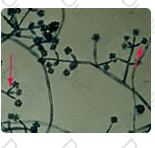
The phialides of Beauveria species are geniculate, forming a zig-zag pattern.
The arrows in the image on the right point to single, long, tapered phialides that extend laterally from either side of the hyphae. This is an identifying feature of which of the fungi listed below?
One of the key characteristics to the identification of Nocardia asteroides is its inability to hydrolyze casein, tyrosine or xanthine, as shown in this photograph. Nitrates are reduced to nitrites. Both Nocardia brasiliensis and Actinomadura madurae hydrolyze both casein and tyrosine; Streptomyces griseus hydrolyzes all three of the substrates.
Illustrated in this photograph is an agar quadrant plate containing casein (A), tyrosine (B), nitrate (C) and xanthine (D). None of the substrates have been hydrolyzed and nitrate has been reduced. The most likely identification is:
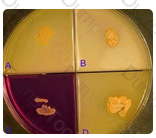
Small, dense LDL is most likely to interact with arterial walls, leading to deposition of cholesterol, and initiating or worsening atherosclerosis. Small, dense LDL is associated with more than a three-fold increase in the risk of coronary heart disease.
Large, buoyant LDL is less atherogenic than small, dense LDL.
The LDL phenotype A is normal. It is the so called 'B' pattern that is associated with increased risk.
Which of the following is most likely to interact with arterial walls, leading to deposition of cholesterol, and initiating or worsening atherosclerosis?
The area of the federal government that ensures that the laboratory is stocked with gloves for their employees when performing tests on patient blood sample is:
HbA1C is the recommended test for monitoring diabetic carbohydrate management. Microalbuminuria, low concentrations of urinary albumin, is measured to detect early renal impairment, at a stage where it is reversible with treatment.
What is the role of microalbuminuria testing?
AHG must be added to the cells immediately following washing. Antibodies may elute from the cells if the cells are allowed to sit in saline without the addition of AHG.
Which one of the following may cause a FALSE-NEGATIVE result with antiglobulin techniques?
Serum amylase and lipase levels may be slightly elevated in chronic pancreatitis, but not diagnostic enough to predict chronic pancreatitis; wheras high levels are found only during acute pancreatitis episodes. In the later stages of chronic pancreatitis, normal to decreased levels of amylase and lipase are caused by the gradual inability of the pancreas to secrete the enzyme
All of the statements below regarding amylase and lipase in pancreatitis are TRUE EXCEPT:
A beam splitter is employed in a dual beam spectrophotometer.
Which of the following is not a component of a basic single beam spectrophotometer:
Post-hepatic obstruction is characterized by a marked increase in alkaline phosphatase, GGT, conjugated bilirubin, as well as other hepatic enzymes. The slight rise of ALT suggests that the issue is not hepatitis. Renal and cardiovascular failure do not match the symptom of jaundice or the abnormal laboratory values.
Chem
Which of the following conditions would be suggested by a jaundiced patient experiencing a marked rise in alkaline phosphatase, conjugated bilirubin, and a slight rise in ALT:
Serum alkaline phosphatase is produced in the bone, intestine, and the placenta- but not in the brain.
Serum alkaline phosphatase activity is derived from all of the following organs except:
High triglycerides may be caused by disorders such as type 2 diabetes, hypothyroidism, Cushing's sydnrome, liver disease, uremia, dysglobulinemia, nephrotic syndrome, and alcoholism can cause hypertriglyceridemia.
A 46-year old known alcoholic with liver damage is brought in the ER unconscious. One would expect his lipid values to be affected in what way?
The identification of the crystals depicted in this image are triple phosphate crystals. Triple phosphate crystals may be normal but are usually associated with alkaline urine. These colorless crystals have a characteristic "coffin lid" appearance.
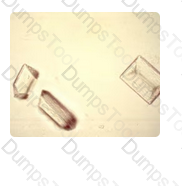
What is the identification of these crystals seen in urine with an alkaline pH?
Primary- Target glands (such as thymus, thyroid, parathyroid, etc.)
Secondary- Pituitary gland
Tertiary- Hypothalamus
Match the type of endocrine dysfunction with the appropriate organ:
1. Target gland
2. Pituitary gland
3. Hypothalamus
This antibody is found in the serum of Le(a-b-) secretors.
Which one of these Lewis blood group system phenotypes usually produces anti-Lea?
Hemoglobin F has a high affinity for oxygen. When Hb F is elevated, cells containing Hb S are more oxygenated and do not sickle as readily as they would if Hb F were not present or present in small quantities.
Which hemoglobin, when elevated, acts as a protection against sickling in patients with HbS?
These are tyrosine crystals

Urinalysis & Other Body Fluids
True or false? Cystine crystals are present on this slide.
Nucleated RBCs may be seen in the peripheral blood in cases of beta thalassemia major. Nucleated RBCs are usually not found in peripheral blood in cases of beta thalassemia minor and beta thalassemia intermedia, and would not be a finding in beta thalassemia minima.
Nucleated RBCs are most likely to be seen in the peripheral blood of which of these beta thalassemias?
The structures involved in the production of semen include the prostate, the seminal vesicles, and the bulbourethral gland, along with the testes and epididymis.
Semen is produced as a combination of secretions from the different regions of the male reproductive tract. Each fraction differs in chemical composition and function.
Spermatozoa are produced in the testes. They mature in the epididymis. The testes also produce testosterone and inhibin.
Fluid from the seminal vesicles accounts for approximately 70% of semen volume. The seminal vesicles are the source of fructose in semen. Fructose is used by the spermatozoa as an energy source.
The prostate gland supplies about 20% of the volume of semen. Its fluids include acid phosphatase and proteolytic enzymes that lead to coagulation and subsequent liquefaction of semen. The prostate also contains most of the IgA found in semen.
The bulbourethral gland produces mucoproteins that make up about 5% of the volume of semen.
The pituitary gland is not directly involved in the production of semen; instead hormones are released which stimulate the production of sperm. The urethra is not involved in the production of semen.
Which of the following are directly involved in the production of semen?
Blood collected in CPDA-1 may be stored at 1 - 6 oC for up to 35 days.
How long may blood be stored using CPDA-1 preservative prior to transfusion?
In an alkaline medium, potassium ferricyanide oxidizes hemoglobin to methemoglobin. Further reaction with potassium cyanide produces cyanmethemoglobin which has a maximum absorbance at 540 nm. Color intensity is proportional to total hemoglobin concentration, which is how the hemoglobin levels are measured.
Hematology
In the hemoglobin methodology using potassium ferricyanide the following measurable reaction occurs:
Pluripotential stem cells are ultimately capable of differentiating into all types of leukocytes.
Hematology
Pluripotential stem cells are capable of producing which of the following:
Which of the following legislation was developed to protect the privacy of all patient information in the health care?
The image shown in this question is depicting a rosette formation. Here the red blood cells are surrounding and adhering to the outside of the white blood cell.
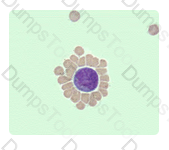
What is the best description of the phenomenon seen in this illustration?
Fatty casts contain refractile oval fat bodies or free fat droplets. They are derived from renal tubular cells, and may be seen in nephrotic syndrome.
Identify the urine sediment element:
Abrupt change in temperature is one of the risk factors in which a sickling event may occur.
Dehydration, hypoxia, and physical exertion, rather than excessive intake of fluids, inhaling oxygen, and sedentary lifestyle, are all additional risk factors in which sickling events may occur.
Which of these could cause a sickling event?
The Westgard multi-rule 22S describes the scenario where two consecutive data points fall outside +2SD or -2SD. If this occurs, then the run must be rejected. This situation is most likely caused by a systematic error.
Which of the following describes the Westgard multi-rule 22S?
A hapten is an incomplete antigen.
All of the following cellular antigens are important to an immunohematologist except:
This patient is most likely suffering from sickle cell anemia. This cell, which is sickle-shaped, is indicative of the presence of hemoglobin S. Polychromasia is also commonly observed in sickle cell anemia.
After experiencing crippling pain in her chest, Elizabeth's mother rushes her to the Emergency Room. After a complete blood count and differential are ordered, the hematology technologist views many peripheral cells similar in appearance to those found in the image below. Which condition is most likely present?
Alpha-fetoprotein is a substance typically used in the triple test during pregnancy and for screening chronic liver disease patients for hepatocellular carcinoma.
Increased concentrations of alpha-fetoprotein (AFP) in adults are MOST characteristically associated with:
FAB M5 is acute monoblastic leukemia
FAB M1 is acute myeloblastic leukemia without maturation
FAB M3 is acute promyelocytic leukemia
FAB M4 is acute myelomonocytic leukemia
Which FAB designation is called the "true" monocytic leukemia and is characterized by monoblasts, promonocytes, and monocytes?
Creatinine clearance tests are utilized to estimate the glomerular function of the kidney. The creatitine clearance calculation is defined as the volume of plasma that is cleared of creatinine by the kidney per unit of time and uses the following formula:
creatinine clearance = Urine creatinine conc x Volume / Plamsa creatinine conc
Creatinine clearance measurements have a recommended specimen requirement = 24-hour urine collection.
Which of the following tests would be useful in the assessment of glomerular filtration:
Healthcare workers that worked closely with patient specimens were at an increased risk of contracting which viral infection before a vaccine was developed?
The dematiaceous molds can be broadly separated into two major groups: the agents of chromomycosis that grow more slowly, maturing only after 7 days or more of incubation, and the more rapidly growing species that most commonly are clinically insignificant commensals or contaminants when recovered from clinical specimens, but in rare situations may cause opportunistic infections called phaeohyphomycosis.
Dematiaceous molds can be broadly separated into two major groups; the agents of chromomycosis and clinically insignificant commensals or contaminants. The agents of chromomycosis grow: more slowly than; more rapidly than; or generally at the same rate as the clinically insignificant commensals or contaminants?
RAST tests, or Radioallergosorbent tests, are used to screen for an allergy to a specific substance or substances if a person presents with allergy-like symptoms.
The assay which is most helpful in identifying specific allergens is:
An employer who fails to provide sufficient personal protective equipment (PPE) for employees may be fined by the:
Neutrophils, lymphocytes and macrophage/ monocytes can be found in all types of body fluid differentials. Bronchial cells can be found only in bronchial washings and BAL specimens. Mesothelial cells are found only in serous body fluids including pleural fluid, peritoneal fluid, and pericardial fluid.
Select the specific cells listed below that can be found in all types of body fluid.
Transmission-based precautions isolation categories include all of the following except:
Microbiology
Matching: The detection of a distinct odor is often helpful in the presumptive identification of bacterial culture isolates. Match each of the odors listed with its corresponding bacterial species name.
1. Streptococcus anginosus (milleri)
2. Pseudomonas aeruginosa
3. Eikenella corrodens
4. Alcaligenes faecalis
The personal protective equipment (PPE) that is used in the laboratory to protect the personnel when performing tests on patient blood samples is which of the following:
Hemoglobin electrophoresis uses an electric field to separate hemoglobin molecules based on differences in net electrical charge. The rate of electrophoretic migration is also dependent on the ionic radius of the molecule, the viscosity of the solution through which it is migrating, the electrical field strength, temperature, and the type of supporting medium used.
Electrophoretic separation of hemoglobin fundamentally relies on:
Free T4 is affected the least by changes in plasma proteins during pregnancy.
Which of the following thyroid function assays is affected least by pregnancy:
There are many causes of CSF lymphocytosis. Lymphocytosis is seen in viral, fungal, and tuberculous infections, although a predominance of neutrophils may be present in the early stages of these infections. Lumbar puncture to obtain CSF samples is often contraindicated in those with a suspected brain abscess.
CSF lymphocytosis is associated with all of the following except:
The morphologic characteristic(s) associated with the Chediak-Higashi syndrome is (are):
A laboratory scientist is working the night shift at a local hospital when the power goes out. What is the course of action to continue to provide laboratory results?